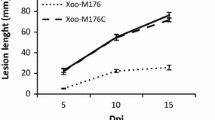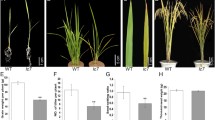Abstract
Rice blast, caused by Magnaporthe oryzae, is a serious threat to global rice production. In recent years, many pathogenicity genes of M. oryzae have been identified, although most of their functions remain unknown. In this study, we report the synergistic deletion of RGS1 and COS1 that may reduce the pathogenicity of M. oryzae. The investigation involved comparing ΔMorgs1, ΔMocos1, and ΔMorgs1/ΔMocos1 mutants. The ΔMorgs1/ΔMocos1 mutant showed a weak reduction in vegetative growth, and the colonies displayed fewer and smoother aerial hyphae. The ΔMorgs1/ΔMocos1 mutant exhibited delayed appressorium-like structure formation and ‘low pathogenicity’ on detached rice seedling leaves when compared with ΔMocos1. Moreover, the melanin content of the single and double mutants was remarkably lower than that of the WT type. Thus, our results indicate that the synergy between RGS1 and COS1 may be crucial in the pathogenicity of M. oryzae.






Similar content being viewed by others
Abbreviations
- CM:
-
Complete medium
- DHN:
-
1,8-Dihydroxynaphthalene
- OMA:
-
Oatmeal agar
- qRT-PCR:
-
Quantitative reverse-transcription-polymerase chain reaction
- WT:
-
Wild type
References
Bell AA, Wheeler MH (1986) Biosynthesis and functions of fungal melanins. Annu Rev Phytopathol 24:411–451
Chumley FG, Valent B (1990) Genetic analysis of melanin-deficient nonpathogenic mutants of Magnaporthe grisea. Mol Plant Microbe Interact 3:135–143
Eisenman HC, Casadevall A (2012) Synthesis and assembly of fungal melanin. Appl Microbiol Biotechnol 93:931–940
Fan R, Klosterman SJ, Wang C, Subbarao KV, Xu X, Shang W, Hu X (2017) Vayg1 is required for microsclerotium formation and melanin production in Verticillium dahliae. Fungal Genet Biol 98:1–11
Howard RJ, Valent B (1996) Breaking and entering: host penetration by the fungal rice blast pathogen Magnaporthe grisea. Annu Rev Microbiol 50:491–512
Jacobson ES (2000) Pathogenic roles for fungal melanins. Clin Microbiol Rev 13:708–717
Kim S, Ahn IP, Rho HS, Lee YH (2005) MHP1, a Magnaporthe grisea hydrophobin gene, is required for fungal development and plant colonization. Mol Microbiol 57:1224–1237
Langfelder K, Streibel M, Jahn B, Haase G, Brakhage AA (2003) Biosynthesis of fungal melanins and their importance for human pathogenic fungi. Fungal Genet Biol 38:143–158
Lee BN, Adams TH (1994) The Aspergillus nidulans fluG gene is required for production of an extracellular developmental signal and is related to prokaryotic glutamine synthetase I. Genes Dev 8:641–651
Li XY, Han XX, Liu ZQ, He C (2013) The function and properties of the transcriptional regulator COS1 in Magnaporthe oryzae. Fungal Biol 117:239–249
Liu KJ, Suresh A, Willard FS et al (2014) Rgs1 regulates multiple Gα subunits in Magnaporthe, pathogenesis, asexual growth and thigmotropism. Embo J 26(3):690–700
Livak KJ, Schmittgen TD (2001) Analysis of relative gene expression data using real-time quantitive PCR and the 2-∆∆C t method. Methods 25:402–408
Maciel JL, Ceresini PC, Castroagudin VL, Zala M, Kema GH, McDonald BA (2014) Population structure and pathotype diversity of the wheat blast pathogen Magnaporthe oryzae 2.5 years after its emergence in Brazil. Phytopathology 104:95–107
Matheis S, Yemelin A, Scheps D et al (2017) Functions of the Magnaporthe oryzae Flb3p and Flb4p transcription factors in the regulation of conidiation. Microbiol Res 196:106
Morris-Jones R, Gomez BL, Diez S, Uran M, Morris-Jones SD, Casadevall A, Nosanchuk JD, Hamilton AJ (2005) Synthesis of melanin pigment by Candida albicans in vitro and during infection. Infect Immun 73:6147–6150
Nalley L, Tisboe F, Durand-Morat A, Shew A, Thoma G (2016) Economic and environmental impact of rice blast pathogen (Magnaporthe oryzae) alleviation in the United States. PLoS One 11:e0167295
Ramanujam R, Yishi X, Liu H, Naqvi NI (2012) Structure-function analysis of Rgs1 in Magnaporthe oryzae: role of DEP domains in subcellular targeting. PLoS One 7:e41084
Silue D, Tharreau D, Talbot NJ, Clergeot PH, Notteghem JL, Lebrun MH (1998) Identification and characterization of apf1—in anon-pathogenic mutant of the rice blast fungus Magnaporthe grisea which is unable to differentiate appressoria. Physiol Mol Plant Pathol 53:239–251
Talbot NJ (2003) On the trail of a cereal killer: exploring the biology of Magnaporthe grisea. Annu Rev Microbiol 57:177–202
Wang ZY, Soanes DM, Kershaw MJ, Talbot NJ (2007) Functional analysis of lipid metabolism in Magnaporthe grisea reveals a role for peroxisomal fatty acid beta-oxidation during appressorium-mediated plant infection. Mol Plant Microbe Interact 20:475–491
Weijn A, Bastiaan-Net S, Wichers HJ, Mes JJ (2013) Melanin biosynthesis pathway in Agaricusbisporu smushrooms. Fungal Genet Biol 55:42–53
Wilson RA, Talbot NJ (2009) Under pressure; investigating the biology of plant infection by Magnaporthe oryzae. Nat Rev Microbiol 7:185–195
Zhang CQ, Zhu GN, Ma ZH et al (2010) Isolation, characterization and preliminary genetic analysis of laboratory tricyclazole-resistant mutants of the rice blast fungus, Magnaporthe grisea. J Phytopathol 154(7–8):392–397
Zhou ZZ, Li G, Lin C, He C (2009) Conidiophore Stalk-less1 encodes a putative zinc-finger protein involved in the early stage of conidiation and mycelial infection in Magnaporthe oryzae. Mol Plant Microbe Interact 22:402–410
Funding
This work was supported by the National Natural Science Foundation of China (Grant no. 31260418).
Author information
Authors and Affiliations
Corresponding author
Ethics declarations
Conflict of interest
The authors declare that they have no conflict of interest.
Additional information
Communicated by Erko Stackebrandt.
Publisher’s Note
Springer Nature remains neutral with regard to jurisdictional claims in published maps and institutional affiliations.
Rights and permissions
About this article
Cite this article
Na, H., Bang, A., Qing-biao, X. et al. Synergistic deletion of RGS1 and COS1 may reduce the pathogenicity of Magnaporthe oryzae. Arch Microbiol 201, 807–816 (2019). https://doi.org/10.1007/s00203-019-01646-8
Received:
Revised:
Accepted:
Published:
Issue Date:
DOI: https://doi.org/10.1007/s00203-019-01646-8




